![]()
![]()
![]()
Use LEFT and RIGHT arrow keys to navigate between flashcards;
Use UP and DOWN arrow keys to flip the card;
H to show hint;
A reads text to speech;
12 Cards in this Set
- Front
- Back
- 3rd side (hint)
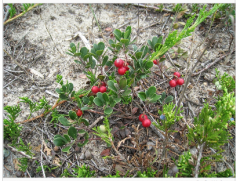
|
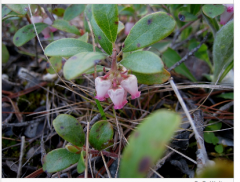
Arctostaphylos uva-ursi |
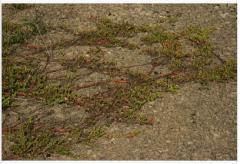
BEARBERRY, KINNIKINICK
Ericaceae
One of the few species of Ericaceae not characteristic of acid habitats. Often forms large mats on sand dunes as well as jack pine and oak plains and on limestone pavements and gravel ridges (or other rock in the western Upper Peninsula). The generic name and specific epithet both mean “bearberry,” in Greek and Latin, respectively. Whether the species forms any part of the diet of bears is, however, doubtful. The leaf blades are mostly 1–2.5 cm long, often slightly obovate. |
|
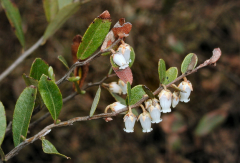
|

Chamaedaphne calyculata |
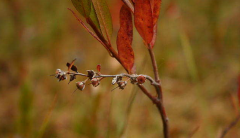
LEATHERLEAF
Ericaceae
Doubtless our most abundant “bog shrub,” often forming very large clones, with lower stems buried in sphagnum, peat, or other substrate (and apparently ± resistant to fire). Can be expected in every open bog and many shrubby fens, wet or dryish, even persisting long after drying or burning of the peat or succession to swamp; small plants also grow in rock crevices and pool margins along Lake Superior, as at Isle Royale. |
|
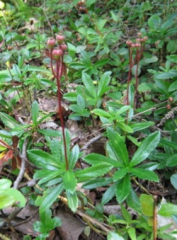
|
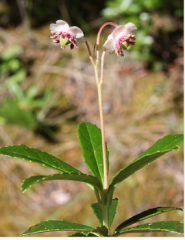
Chimaphila umbellata |
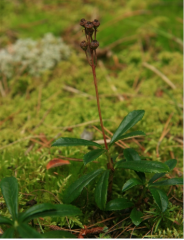
PIPSISSEWA, PRINCE'S-PINE
Ericaceae
In a great diversity of dry to boggy forests, especially with pine and oak, persisting after some disturbance; dry, rocky openings and thickets. Very local in the southernmost part of the state. The pink flowers nod in an inflorescence held above the crowded glossy-green leaves; it is a very attractive species blooming in mid- to late summer. The fruit, unlike the flowers, is held erect. |
|
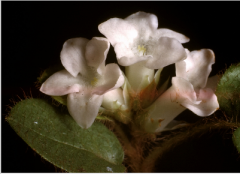
|

Epigea repens |
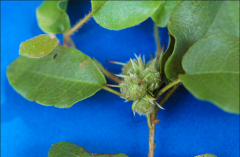
Trailing arbutus
Ericaceae
Typically in dry, usually sandy savanna and forest with oak, aspen, and pines, but also sometimes associated with beech, maple, and/or hemlock and in swamps of cedar or other conifers. The exquisitely fragrant flowers, in dense clusters, often nearly hidden on the ground beneath the leaves of this and other plants, open early in the spring, by mid-April or mid-May depending on season and latitude, with some lingering till the first of June in late seasons. The corollas are white to pink, the pink shade intensifying with age. The stem, petioles, and usually leaf blades (especially on margins and veins beneath) are ± shaggy with stiff rusty-brown hairs. |
|
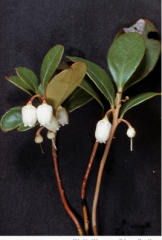
|
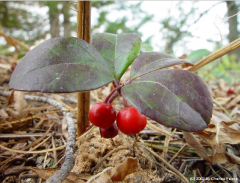
Gautheria procumbens |
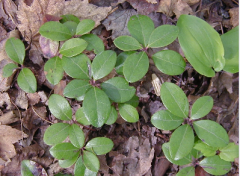
Teaberry/Wintergreen
Ericaceae
Thrives in dry, usually ± sandy savanna with oak, pine, paper birch, aspen, red maple, bracken, blueberry; but also frequent in moist forests, even conifer swamps; less often with beech, maple, hemlock. Generally thought to be a species that does well after fire. The wintergreen flavor and aroma are stronger in leaves and fruits than in G. hispidula. The tender young leaves are most palatable, and the old ones can be used for tea. Commercial wintergreen oil, however, if not wholly synthetic, is now more likely to be extracted from Betula lenta than from Gaultheria. |
|
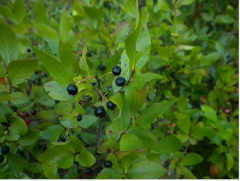
|
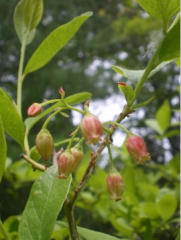
Gaylussacia baccata |
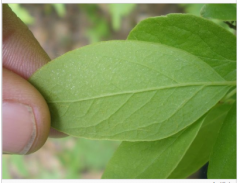
Black Huckleberry
Ericaceae
Thrives in acid situations, from old dunes and plains with oak, pine, and birch to wet bogs with such genera asChamaedaphne and Larix. The nearly black (very rarely glaucous) fruit ripens distinctly later than the common blueberries, with which it may grow. The corollas vary from yellow to a rich reddish, but rarely they or the fruit may be white. The leaves, which turn a handsome red in the fall, can be rubbed between the fingers or on a piece of paper to see the characteristic resinous substance which, besides the fruit, readily distinguishes our true huckleberry from the blueberries. |
|

|
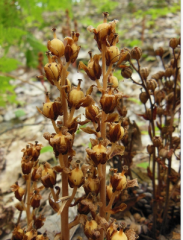
Hypopitys monotropa |
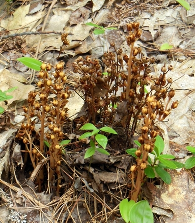
PINESAP, FALSE BEECH-DROPS
Ericaceae
Coniferous or deciduous forests or even conifer swamps. Specimens in fruit might be mistaken for small ones ofPterospora andromedea; besides lacking the clammy pubescence of that species, the style is 2.4–5 mm long, hirsute, and noticeable on the fruit. In Pterospora, the style is ca. 2 mm long or less, glabrous, and nearly or quite concealed by the expanding fruit. Neyland & Hennigan (2004) present clear evidence supporting the recognition of Hypopitys. |
|
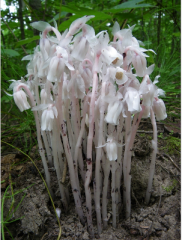
|
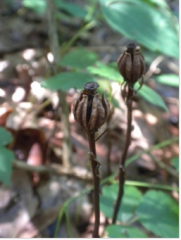
Monotropa Uniflora |
![INDIAN-PIPE
Ericaceae
Usually in slightly more moist forests than Hypopitys monotropa, occasionally even in deep sphagnum moss in a bog.
Plants of decided pink color [f. rosea Fosberg] have been found in Barry, Cheboyg...](https://images.cram.com/images/upload-flashcards/86/31/63/8863163_m.png)
INDIAN-PIPE
Ericaceae
Usually in slightly more moist forests than Hypopitys monotropa, occasionally even in deep sphagnum moss in a bog. Plants of decided pink color [f. rosea Fosberg] have been found in Barry, Cheboygan, Lenawee, Luce, and Newaygo Cos. |
|
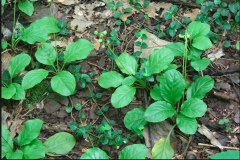
|
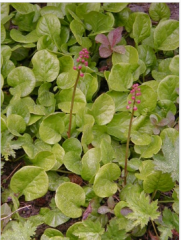
Pyrola spp. |
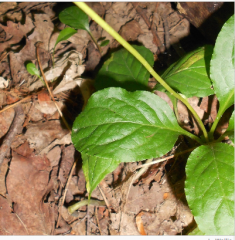
SHINELEAF, LARGE-LEAVED SHINELEAF, PINK PYROLA
from wet to dry forests
Shineleaf: Moist to rather dry coniferous or mixed forests, often in moss or litter of conifer needles. The leaf blades are only rarely as long as 3–4 cm, whereas they are longer in P. elliptica and, often, in P. americana and P. asarifolia. The bracts in the raceme may overlap in size those of P. elliptica, P. americana, and P. asarifolia, but they tend to be more often minutely toothed or papillose on the margins and to be partly adnate to the pedicels. |
|
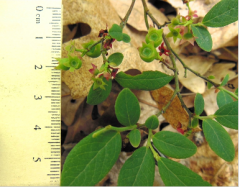
|
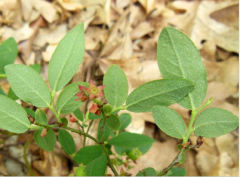
Vaccinium angustifolium |
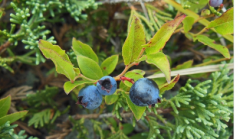
LOW-SWEET BLUEBERRY
Ericaceae
Often abundant (and much sought by berry pickers) in dry, sandy or rocky, open or ± shaded ground with oak, pines, and/or aspen; but also in moist places, including peatlands with Chamaedaphne and other shrubs, though less frequently than V. myrtilloides in such places; thrives after clearing or burning. A polymorphic tetraploid complex; plants with green leaves but blue-glaucous fruit have been segregated from the narrowest interpretation of V. angustifolium as var.laevifolium House or V. lamarckii Camp. Plants with glaucous leaves, but dark blue-black fruit have been segregated as var. nigrum (Alph. Wood) Dole or V.brittonii E. P. Bicknell. The two phases often grow together and are usually quite distinct, but they apparently cross-pollinate freely and do not breed true. |
|
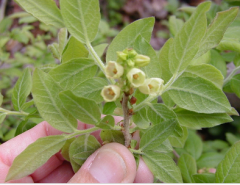
|
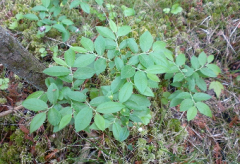
Vaccinium myrtilloides |
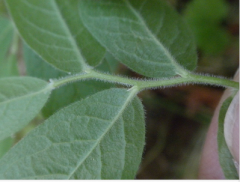
VELVETLEAF BLUEBERRY, CANADA BLUEBERRY
Ericaceae
Thrives on dry sandy or rocky open or ± shaded ground, often with V. angustifolium but, more frequently than that species, also found in moist places, including bogs and swamps. Quite distinct in its entire, ± densely pubescent leaves. The fruit is usually blue with a glaucous bloom, but may be purple-black; the white-fruited f. chiococcum (W. Deane) Fernald has been collected in Cheboygan, Houghton, and Marquette Cos. and doubtless occurs elsewhere. (The dried fruit has turned blue on all these specimens.) |
|
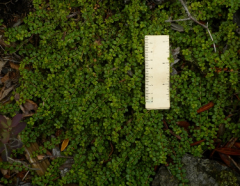
|
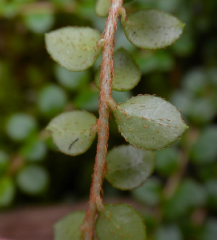
Gautheria hispidula |
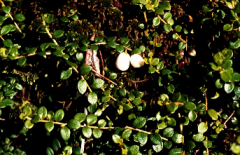
CREEPING-SNOWBERRY
Ericaceae
Forming flat mats in moist forests, thickets, and swamps of cedar, spruce, tamarack, or other conifers; often on mossy logs and hummocks. The foliage is sometimes confused with that of the cranberries, but differs in the wintergreen flavor, strigose stems, more acute leaf tips, green undersides of the leaves, and bristle-like glands or hairs on the undersides (and often margins) of the leaves. |

